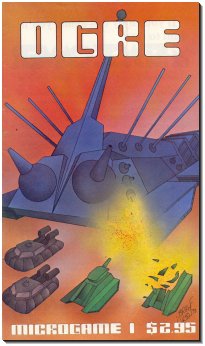
OGRE is a science fiction board wargame designed by the American game designer Steve Jackson and published by Metagaming Concepts in 1977 as the first microgame in its MicroGame line. When Jackson left Metagaming to form his own company, he took the rights to OGRE with him, and all subsequent editions have been produced by Steve Jackson Games (SJG).

G.E.V. is a science fiction board wargame that simulates combat in the near future between armored hovercraft, supertanks and other futuristic weaponry.

Squad Leader is a tactical level board war game originally published by Avalon Hill in 1977. It was designed by John Hill and simulates on infantry combat in Europe during World War II. One of the most complex war games of its time, Squad Leader is the natural extension of the trend towards greater realism initiated by several earlier games, including Avalon Hill's own PanzerBlitz and Panzer Leader. Those two earlier games were slightly larger in scope, with counters representing platoons and map hexes measuring 250 metres across, compared to Squad Leader's 40 meter hexes and squad sized units.

The Russian Campaign is a strategic board wargame published by Jedko Games in 1974 that simulates combat on the Eastern Front during World War II. Avalon Hill later bought the game and produced several editions.

Battle of the Bulge is a board wargame published by Avalon Hill (AH) in 1965 that simulates the World War II battle of the same name. General Anthony McAuliffe (ret.), who had been commanding officer at Bastogne during the Battle of the Bulge, was a consultant during the game's development. The game proved popular and sold more than 120,000 copies, but was dogged by criticisms of historical inaccuracies, and was finally replaced by a completely new edition in 1981. A third edition in 1991 was released as part of the Smithsonian American History Series.
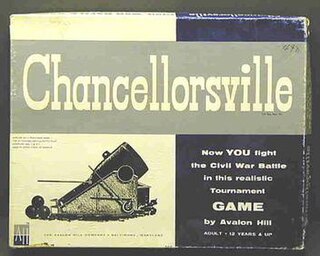
Chancellorsville is a board wargame produced by Avalon Hill in 1961, and republished in 1974 that simulates the Battle of Chancellorsville during the American Civil War.
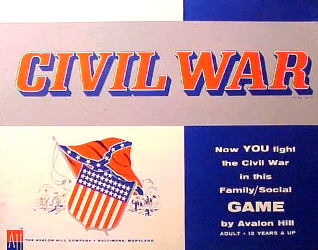
Civil War is an early strategic board wargame published by Avalon Hill in 1961 that simulates the American Civil War. Unlike other games produced by Avalon Hill during this period such as Gettysburg, Civil War did not sell well and was dropped from production two years later.

Stalingrad is a strategic-level board wargame published by Avalon Hill in 1963 that simulates the first 24 months of the war between Germany and the Soviet Union during World War II. As one of the first board wargames it was extensively played and discussed during the early years of the wargaming hobby.

Stellar Conquest is a science fiction board game published by Metagaming Concepts in 1974.

Panzergruppe Guderian is a board wargame published by Simulations Publications, Inc. in 1976 that simulates the 1941 Battle of Smolensk during World War II.

WarpWar is a science fiction board wargame published by Metagaming Concepts in 1977 that simulates interstellar combat. It was the fourth in Metagaming's MicroGame series.
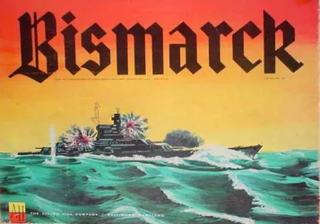
Bismarck is a board wargame published by Avalon Hill in 1962 that simulates the hunt for the Bismarck.

Chitin: I is a science fiction microgame published by Metagaming Concepts in 1977 in which bands of intelligent insects vie for resources.

Arcola, The Battle for Italy 1796 is a board wargame published by Operational Studies Group (OSG) in 1979 and republished by Avalon Hill in 1983 that is a simulation of the Battle of Arcola between French and Austrian forces in 1796. The game was designed to tempt players to purchase OSG's previously published and larger wargame Napoleon in Italy.
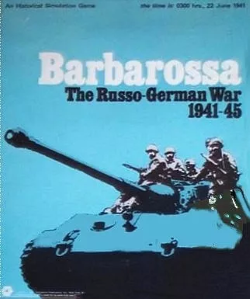
Barbarossa: The Russo-German War 1941–45 is a board wargame published by Simulations Publications Inc. (SPI) in 1969 that simulates the conflict between Germany and the Soviet Union on the Eastern Front of World War II. This was only SPI's second game produced during a preliminary round of "Test Series" games, and proved to be the most popular. Despite the title, taken from the German operational name for their initial invasion of the Soviet Union, the game covers the entire Eastern Front campaign from the German invasion in 1941 to the Fall of Berlin in 1945.

The Game of France, 1940: German Blitzkrieg in the West, originally titled "The Battle for France, 1940", is a board wargame originally published by Simulations Publications Inc. (SPI) in 1971 that was subsequently re-issued by Avalon Hill in 1972. Both editions simulate the World War II Battle of France in 1940, when the German blitzkrieg offensive overwhelmed French and British defenses in northern France.

KampfPanzer: Armored Combat, 1937–40 is a board wargame published by Simulations Publications Inc. (SPI) in 1973 that simulates the first battles involving battle tanks.
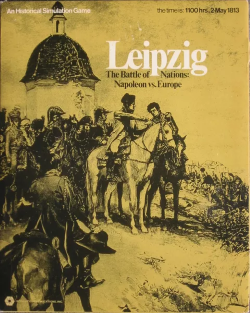
Leipzig: The Battle of Nations, subtitled "Napoleon vs. Europe", is a board wargame published by Simulations Publications Inc. (SPI) in 1969 that simulates the 1813 campaign of Napoleon in central Europe, including the Battle of Leipzig. The game was one of the first Napoleonic board wargames, and a number of innovative rules such as the effect of individual leaders on combat were adopted by other wargame publishers.
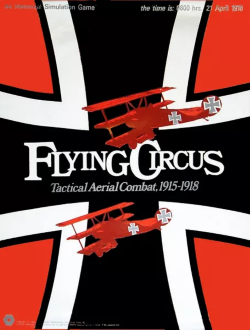
Flying Circus, subtitled "Tactical Aerial Combat, 1915–1918", is a board wargame published by Simulations Publications Inc. (SPI) in 1972 that simulates aerial combat during World War I.
World War II: European Theater of Operations is the title of two related but dissimilar board wargames that simulate the European Theater of World War II. The first was published by Simulations Publications Inc. (SPI) in 1973, and the second by TSR in 1985 following its takeover of SPI.





















